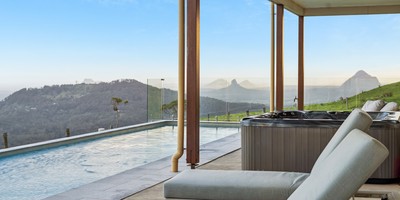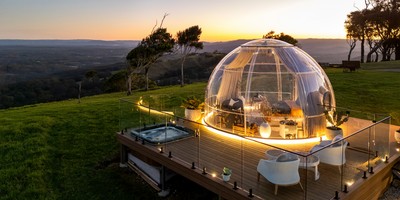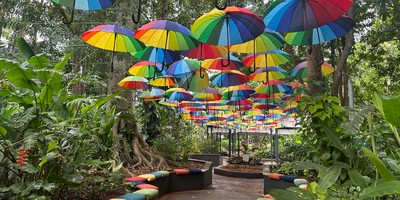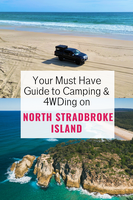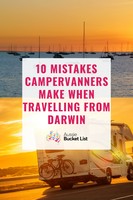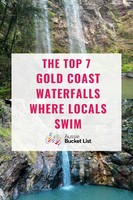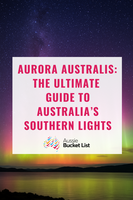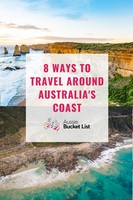Top Family Friendly Waterfall Hikes on the Gold Coast
Gold Coast, QLD 22 April 2024
Continue reading for our curated Bucket List of the top family friendly waterfall hiking trails on the Gold Coast.
For further information including directions to each of these falls, click through to the waterfall listing on our Aussie Bucket List website or app, and scroll down to the bottom to see their locations pinned on Google maps. You can then easily get directions from your current location to each of the waterfalls listed below.
About Destination
The Gold Coast Hinterland is a lush, mountainous region located inland from the famous Gold Coast beaches in Queensland, Australia. Renowned for its natural beauty, this area is characterized by dense rainforests, rolling hills, dramatic waterfalls, and scenic mountain views. It offers a striking contrast to the bustling coastal strip, making it a popular destination for nature lovers, hikers, and those seeking a peaceful retreat.
Key highlights of the Hinterland include Lamington National Park, part of the UNESCO World Heritage-listed Gondwana Rainforests of Australia, which boasts over 160 kilometers of walking trails through ancient rainforests. The park is home to diverse wildlife, including rare species of birds, such as the Albert’s lyrebird, and native plants like the ancient King Fern. Another major attraction is Springbrook National Park, known for its stunning natural features such as Purling Brook Falls and the Natural Bridge, a rock formation that frames a picturesque waterfall.
The Hinterland also features charming villages such as Montville, Maleny, and Canungra, each offering a blend of boutique shops, cafes, and art galleries. These towns are known for their relaxed, country atmosphere and their focus on local produce, including organic food, cheeses, and wines.
Additionally, the region is rich in Aboriginal heritage, with many cultural sites that provide insight into the area's traditional history. Visitors can engage in a variety of activities such as hiking, wildlife watching, wine tasting, and exploring local markets.
Overall, the Gold Coast Hinterland is a tranquil, scenic escape from the coastal crowds, offering a mix of outdoor adventure, cultural experiences, and natural beauty. With so many breathtaking landscapes and charming villages to discover, it’s the perfect place to take memorable photos and later arrange them with a photo collage maker.
Climate
The climate of the Gold Coast Hinterland is characterized by mild, subtropical conditions, with distinct variations in temperature and rainfall due to its elevated, mountainous terrain. The region experiences cooler temperatures compared to the nearby coastal areas, particularly in the higher altitudes of the hinterland's national parks and villages.
Summer in the hinterland is warm, with daytime temperatures ranging from 20°C to 30°C (68°F to 86°F). The area can receive moderate to high rainfall during the summer months, especially from December to February, due to the influence of tropical weather systems and monsoonal rains. Humidity levels can also be high during this period, contributing to a lush, green landscape.
Winter (June to August) brings cooler and drier conditions, with temperatures often ranging from 10°C to 22°C (50°F to 72°F), making it a comfortable time to visit. Frost can occasionally occur in the higher elevations, but snowfall is extremely rare. The cooler temperatures in winter provide a refreshing contrast to the warmer coastal climate.
Rainfall is more consistent year-round in the hinterland due to the orographic effect, where moist air from the coast is lifted over the mountains, leading to frequent rainfall. As a result, the hinterland is home to the subtropical rainforests and rich vegetation that define the area’s unique ecosystems.
In summary, the Gold Coast Hinterland enjoys a mild subtropical climate, with warm, humid summers and cooler, drier winters. Its higher elevation and consistent rainfall support the region's lush vegetation and diverse wildlife, making it a popular destination for nature lovers year-round.
location
The Gold Coast Hinterland is located just inland from the iconic Gold Coast in southeastern Queensland, Australia. It stretches from the southern end of the Gold Coast region, near the border with New South Wales, and extends across a diverse landscape of mountains, valleys, and forests. The hinterland lies roughly 30 to 40 kilometers (19 to 25 miles) from the coastline, providing a stark contrast to the urbanized coastal strip.
This region is part of the larger Scenic Rim area, which includes several national parks and protected areas, such as Lamington National Park, Springbrook National Park, and the Tamborine Mountain region. The Hinterland is positioned within the Great Dividing Range, with peaks rising to over 1,100 meters (3,600 feet) above sea level, offering panoramic views over the surrounding landscape and out to the Pacific Ocean.
The area is easily accessible from the Gold Coast, with several main roads, including the Pacific Motorway, leading into the Hinterland from the coast. It is also within a short drive from Brisbane, making it a convenient day-trip destination for both locals and tourists.
In addition to its natural beauty, the Gold Coast Hinterland is dotted with small, picturesque towns such as Canungra, Montville, and Maleny, offering a charming rural atmosphere with local artisan markets, cafes, and cultural attractions. The combination of its proximity to the coast and its elevated, tranquil setting makes the Gold Coast Hinterland a sought-after retreat for nature enthusiasts and those looking for a peaceful escape from the city.
how to get there
Getting to the Gold Coast Hinterland is relatively easy, with several transportation options available from the Gold Coast and Brisbane. The region is located just 30 to 40 kilometers (19 to 25 miles) inland from the Gold Coast, making it easily accessible by car, public transport, or organized tours.
By Car:
Driving is the most convenient way to reach the Hinterland. From the Gold Coast, you can take the Pacific Motorway (M1) and follow signs to the Hinterland towns such as Springbrook, Mount Tamborine or O'Reilly's and the national parks. The drive takes approximately 30 to 45 minutes, depending on your starting point and destination. For visitors coming from Brisbane, the Hinterland is about a 1.5-hour drive, with multiple routes available, including the M1 and the Mount Tamborine Road.
By Public Transport:
Public transport options are available, although not recommended. You can take a train or bus to nearby towns like Nerang or Robina, both of which are the closest suburban towns to the Hinterland. From there, you may need to catch a connecting bus or taxi to your final destination. Train services from Brisbane to Nerang are frequent, and bus services link Nerang to various Hinterland locations.
Organized Tours:
For those who prefer a more relaxed experience, there are several tour operators that offer day trips to the Gold Coast Hinterland from both the Gold Coast and Brisbane. These tours typically include transportation, a guide, and visits to popular attractions like Lamington National Park, Springbrook National Park, and Tamborine Mountain.
In summary, getting to the Gold Coast Hinterland is simple, with car travel being the fastest and most flexible option, while public transport and guided tours offer alternative ways to explore the area.
TOP Aussie BUCKET LIST EXPERIENCES
1 - Twin Falls Circuit

Image credit: Aussie Bucket List
Walking trail distance: 4km loop | grade 3
Springbrook National Park has breathtaking lookouts, magnificent waterfalls, dense rainforest and ancient Antarctic beech trees. The park is part of Gondwana Rainforests of Australia World Heritage area. Start the Twin Falls circuit at the Tallanbana picnic area or at the Canyon lookout. Pass behind two waterfalls, through rock clefts and among palms and tree ferns.
Signs along the way guide you through the different forest types. Keep an eye out for the smooth, pink bark of brush box trees that line the track. Similar brush box in other parts of the world heritage area have been radio-carbon dated at 1500 years, making these trees the oldest ever carbon-dated on Australia's mainland! Remember to allow enough time to take in the mountain views and get your fill of photos.
This walk is managed by the Queensland Parks and Wildlife Service. The map on their site only shows an indicative start point; the track route and end point are not shown, and the map cannot be used for navigation purposes. When you are in the park, read the signs at and near the start of the track.
Add Twin Falls to your Aussie Bucket List HERE.
2 - Purlingbrook Falls

Image credit: Tourism and Events Queensland
Walking trail distance: 4km loop | grade 2
Spectacular waterfalls and cool ancient forests await you in the beautiful World Heritage-listed Gondwana rainforest of Springbrook National Park. On this beautiful circuit walk, in the Springbrook Plateau section of the park, pass through open eucalypt forest of New England ash, before descending into the gorge to view the falls from below. After crossing the suspension bridge a steady climb through forest brings the walker back to the picnic area. Look for ancient lepidozamias, colourful hakeas and dazzling wildflowers along the way to this stunning waterfall.
There are 265 steps on this walk and it's easier to walk in a clockwise direction. For visitor safety Purling Brook Falls has a restricted access area at the top and base of the waterfall. There are sheer cliffs and waterfalls so keep to the track. If you've got time, detour on the Warringa Pool track, which leads downstream from the base of the falls; you'll add another 2 kilometres to the walk and need to allow another 40 minutes to return.
Add Purlingbrook Falls to your Aussie Bucket List HERE.
3 - Natural Bridge

Image credit: Queensland Government
Walking trail distance: 1km loop walking trail | grade 2
Natural Bridge is in the western part of Springbrook National Park, part of the Gondwana Rainforests of Australia World Heritage Area. The park's Natural Bridge section features a picturesque rock formation, formed by the force of the waterfall over the basalt cave. It is easily accessible from the Nerang-Murwillumbah Road car park. Follow the easy one kilometre circuit (walk in a clockwise direction) and descend through ancient Gondwana rainforest to the Natural Bridge rock arch. Hoop pines emerging from surrounding forest are living relics of the Jurassic Age, 180 million years ago. During the day spot paradise riflebirds, green catbirds, wompoo fruit-doves and also rare and threatened species like the cascade tree frog, tusked frog, sooty owl and koala. At night join a guided nocturnal tour to see the resident colony of protected glow-worms and microbats. On summer nights, also see luminous fungi and fireflies.
Part of Cave Creek in the Natural Bridge section is a Restricted Access Area.
Swimming in the creek, including within the cave, and access to the creek bank is prohibited.
Add Natural Bridge to your Aussie Bucket List HERE.
4 - Curtis Falls

Image credit: Tourism and Events Queensland
Walking trail distance: 1.1km return | grade 3
Enjoy an enchanting walk through wet eucalypt forest beneath towering flooded gums and into cool and lush rainforest. Look for the beautiful crows nest and staghorn ferns in the canopy, and stop to marvel at the intricate strangler fig. The first view of the falls will take your breath away. Depending on the season, a raging torrent or gentle curtain of water tumbles over huge basalt columns to the pool below. The columns are the legacy of the region's rich volcanic history. Look for basking turtles on fallen logs and see fish and eels in the rock pool. At night, look for glow-worms in the surrounding cliffs.
Note that access to the Curtis Falls rock pool and surrounding area is not permitted—it is a restricted access area for the safety of visitors and the protection of glow-worm and platypus populations. This walk is managed by the Queensland Parks and Wildlife Service. The map only shows an indicative start point; the track route and end point are not shown, and the map cannot be used for navigation purposes. See www.des.qld.gov.au for detailed maps and the latest park information. When you are in the park, read the signs at and near the start of the track.
Add Curtis Falls to your Aussie Bucket List HERE.
5 - Elabana Falls

Image credit: Tourism and Events QLD
Walking trail distance: 10.9km circuit | grade 4
Elabana Falls are a must-see natural bucket list attraction for keen hikers on the Gold Coast. You can do a shorter version of this trail by just doing the Elabana Falls section and returning back over the same trail.
These spectacular falls are located at O'Reilly's in Lamington National Park on the Gold Coast Hinterland. The falls are located along the Box Forest Circuit, starting from the Green Mountain trailhead at the end of Lamington National Park Road.
There are numerous waterfalls along the way including Elabana Falls, Darragumai Falls, Box Log Falls and Yanbacoochie Falls. This park is part of the Gondwana Rainforests of Australia World Heritage Area, which is famed for its ongoing geological processes, evolutionary history, and diversity of rare, threatened and endemic species.
The circuit is 10.9km and is classed as a grade 4 walking track. QLD Parks advise to allow approximately 4 hours walking time for this walk.
Add Elabana Falls to your Aussie Bucket List HERE.
6 - Cougal Cascades

Image credit: Aussie Bucket List
Walking trail distance: 1.6km return | grade 2
The 800m, bitumen path has a gradual uphill rise and is suitable for prams and assisted wheelchair access. Walk through subtropical rainforest beside Currumbin Creek to a viewing platform overlooking scenic cascades. Follow self-guiding signs to the historic sawmill and discover the park's past. The mill is a vivid reminder of the days when forests were valued only for their millable timber. Take time to reflect on why we need forests like those at Mount Cougal.
Add Cougal Cascades to your Aussie Bucket List HERE.
7 - Cedar Creek Falls

Image credit: Cedar Creek Lodges
Walking trail distance: 900m return | grade 3
Cedar Creek Falls are a must-see Aussie Bucket List natural attraction when visiting the Mount Tamborine section of the Gold Coast Hinterland, in south-east Queensland.
Cedar Creek Falls Lookout – a short and easy 500m return hike to the lookout.
This flat bitumen track from the car park to the lookout is suitable for strollers and assisted wheelchair access. The lookout at the end of the walk offers very nice views of the waterfalls, cascades and a series of rock pools popular with swimmers. This walking track is ideally suitable for the young, the elderly and the disabled, providing spectacular waterfall scenery within a very short walking distance.
Cedar Creek Falls Rock Pools - a 900m return hike from the Cedar Creek Falls lookout, allow about 30 to 40 minutes, moderate grade track with lots of stairs.
The walking track provides access to Cedar Creek and some of its spectacular cascades, waterfalls and rock pools.
Please note that NO glass containers are allowed past the viewing platform, and observe the regulatory notices warning of slippery rocks, steep cliffs and “no go” areas close to the falls.
Add Cedar Creek Falls to your Aussie Bucket List HERE.
ACCOMMODATION
Or, find your dream accommodation on Expedia
We hope that you are able to tick the Kangaroo Island, South Australia off your Aussie Bucket List soon! Feel free to browse our other blog posts for further inspiration on travelling Australia.
Article by Samantha Porter - Aussie Bucket List Founder & Travel Writer
Affiliate Disclosure: The link for accommodation options are with our affiliate Expedia and tour bookings are through our affiliate partner, Rezdy. Please note that at no additional cost to you, we may earn a small commission if you click through and make a purchase (which we are very grateful for). This helps us to continue to write helpful blogs and create useful resources for our Aussie Bucket List community.
Please visit this page HERE for further information on our copyright and disclaimer guidelines.

